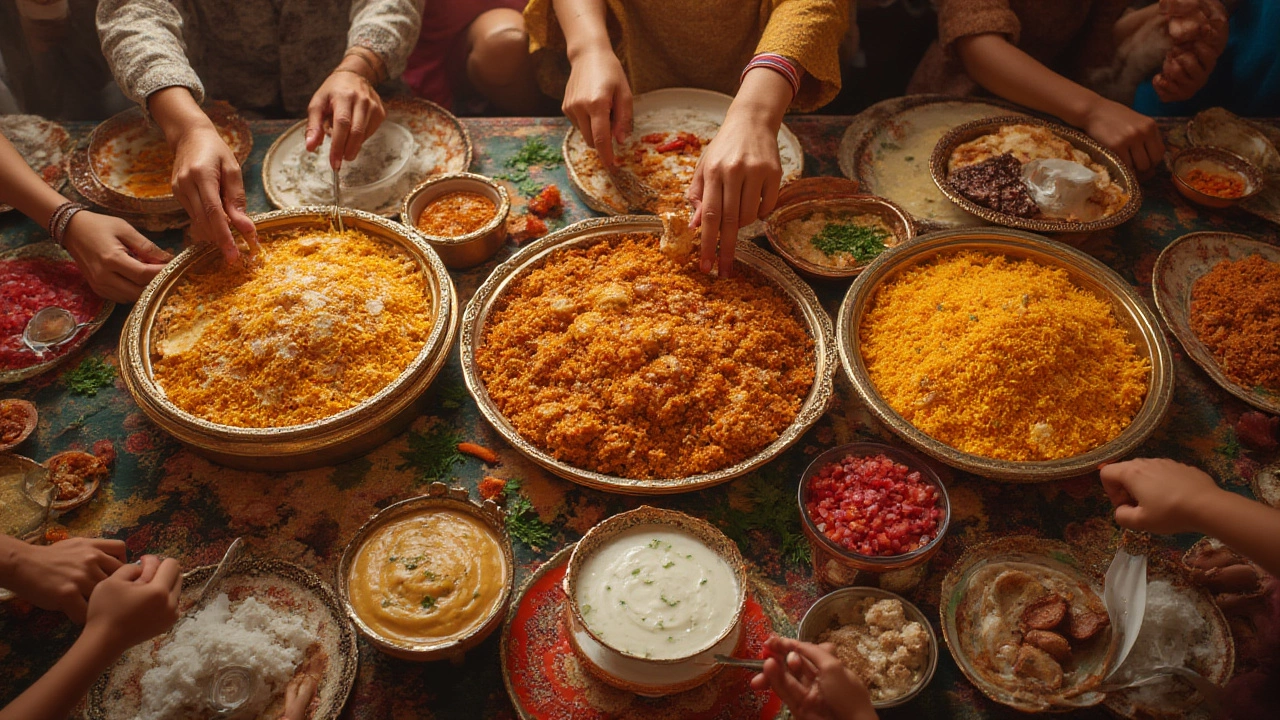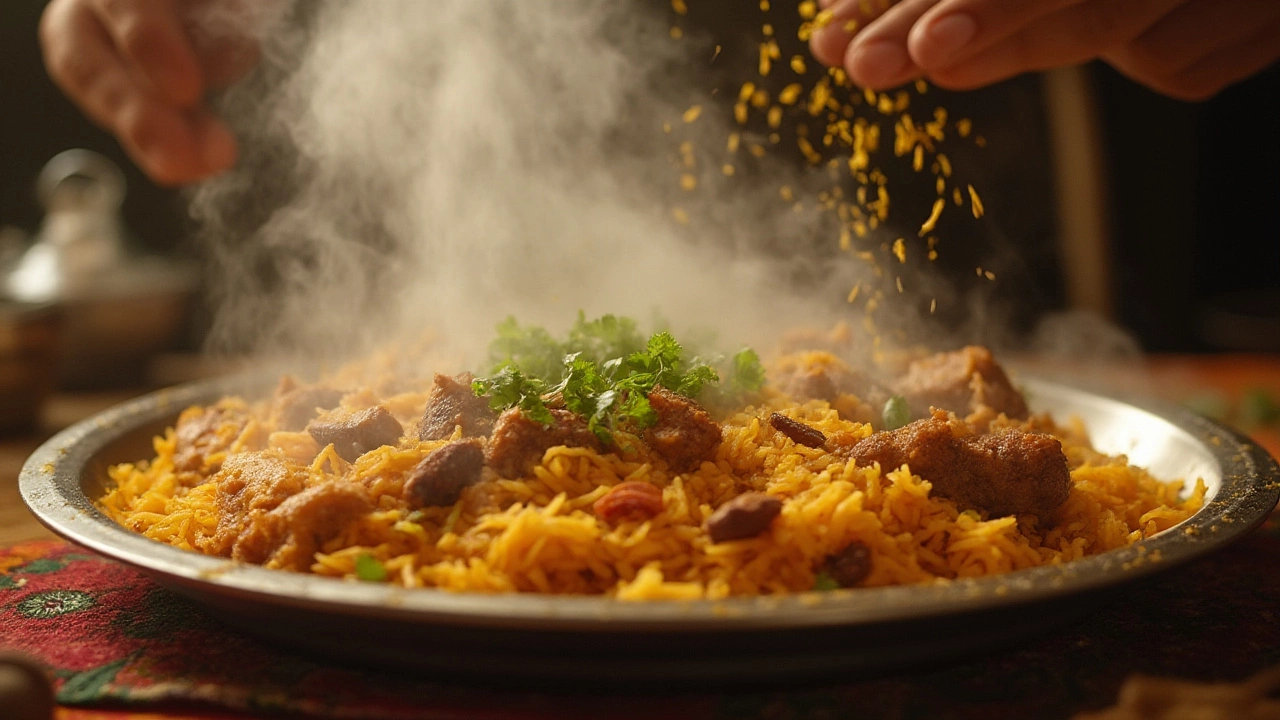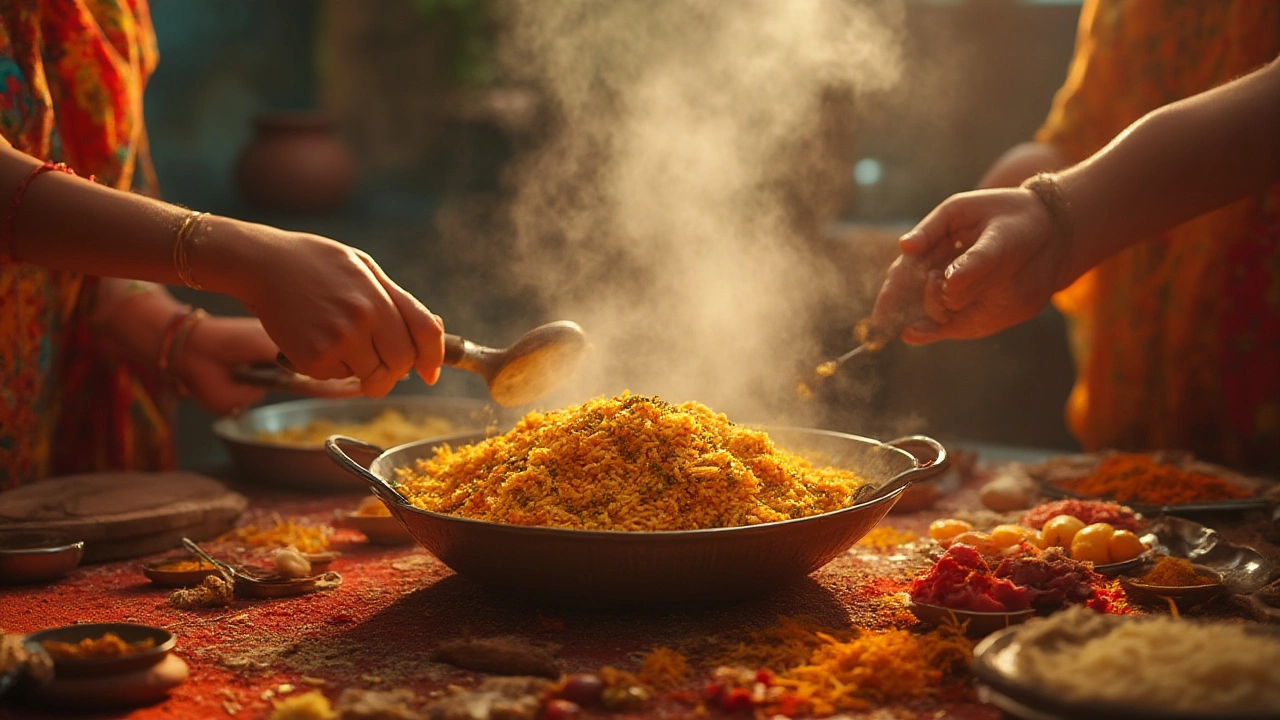The power biryani holds over people is a level-up from other meals. There’s this electrifying thrill when a pot is opened, sending plumes of fragrant steam swirling through the air and making the entire room hush in awe. Even my dog Zoya, who usually ignores human food, can’t help but sneak into the kitchen when there’s biryani on the stove. If you’ve ever wondered why biryani can spark heated debates about authenticity, bring families together, and even cause strangers at a wedding buffet to smile at each other, you’re about to find out. The magic behind biryani's taste is less about mystery and more about some brilliantly executed science, time-honored traditions, and a little bit of wild creativity.
Building Blocks: Ingredients and Layering Like an Artist
Biryani starts with basmati rice. And not just any rice—long grains, aged at least a year, because time dries the kernels, making them perfect for soaking up flavor without going mushy. The rice must be part-cooked separately with whole spices before being layered in the biryani, ensuring every grain stays lively and aromatic. If you’ve ever had a bland biryani, it probably skipped this crucial step. Spice-wise, biryani is a playground: cardamom, cinnamon, star anise, mace, bay leaf, cloves, cumin, nutmeg, and the legendary black stone flower (dagad phool). Each brings its own note to the symphony, and skipping even one can flatten the tune. The meat (or veggies) gets a yogurt marinade—this acid softens fibers, helps spices seep into every bite, and brings a gentle tang. The most die-hard biryani lovers insist on using ghee instead of oil, which melts into a nutty golden gloss you can taste in every spoonful.
Then comes layering: a drama of rice, marinated meat or vegetables, plus fried onions (they’re sweet, crispy, and irreplaceable), mint, cilantro, saffron bloomed in warm milk, and a dash of kewra or rose water. Saffron isn’t just for color—its tiny threads hold a musky perfume that’s impossible to fake. Each layer isn’t just stacked but constructed to let air and flavor travel between them while the final steam cooks everything together in harmony.
If you’re new to making biryani, here’s a tip: don’t dump everything in at once and hope for the best. That’s how you get soggy bottom layers and dry tops. Think of it like terraced farming, not a casserole. A friend once joked that biryani is like building a seven-layer cake—but with more anticipation, and, if you do it right, zero regret.
Check out this quick breakdown of essential biryani ingredients and their roles:
| Ingredient | Role in Taste/Aroma |
|---|---|
| Basmati Rice | Main texture & aroma base |
| Yogurt | Tenderizes meat, slightly acidic, creates depth |
| Ghee | Richness, nutty fragrance |
| Fried Onions | Sweetness, savory crunch, visual appeal |
| Mint & Cilantro | Fresh, green burst |
| Saffron | Luxury aroma, gold color |
| Kewra/Rose Water | Floral, exotic finish |
| Whole Spices | Framework of flavor |
The secret is balance. If you miss out on even one, biryani loses some of its magic.

Timing, Temperature, and the DUM Effect
Now let’s talk heat. Authentic biryani is all about embracing patience. It’s not enough to just boil rice and meat separately then combine them. What truly bridges everything is the legendary 'dum'—slow, sealed cooking where rice, protein, and spices finish together. The biryani pot is sealed with dough or foil, so steam doesn’t escape. This does two things: first, it helps every ingredient swap flavors with its neighbors; second, it ensures that the rice finishes cooking only from the trapped moisture inside, so the grains separate and stay fluffy. It’s a bit theatrical—waiting, sniffing for the first hints of finished biryani in the air—but this wait is what transforms all those raw bits into something gold-standard.
- The Maillard Reaction: When onions are caramelized just right, they’re sweet and earthy, boosting biryani’s umami depth.
- Gentle Steaming: Trapped steam infuses every grain of rice and all the protein, blending them perfectly so you don’t have sad, flavorless bits sitting at the bottom.
- Temperature Control: Too high and you scorch the base; too low and nothing melds. The gentle finish is what keeps each element vivid but unified.
Modern home cooks sometimes use pressure cookers, but try traditional dum at least once (stack a heavy lid with a pan of water on top if you don’t have dough). It stops moisture escape and lets aromas bloom. If the house smells of biryani in the last ten minutes but you can’t see or touch it—that’s how you know your patience will pay off.
For those obsessed with perfection, the ratio of water to rice, soaking time, and the exact dum duration are sacred stats. Here’s a practical example table that can help you nail these:
| Rice Type | Rice:Water Ratio (for Pre-cooking) | Soaking Time | Dum Time |
|---|---|---|---|
| Aged Basmati | 1:1.5 | 30 mins | 25-30 mins |
| Regular Basmati | 1:1.25 | 15 mins | 20 mins |
Small details make a massive difference. Trust me, your taste buds will thank you for the extra ten minutes of steam.

Hidden Stories in Every Spoon: Regional Twists and Cultural Rituals
You’d think there’s just one 'real' biryani, but no—the world’s got hundreds of versions. In Hyderabad, biryani is robust and punchy, layered with marinated raw mutton and direct heat. Kolkata biryani comes with potatoes, the result of a royal cook stretching rations centuries ago. In Lucknow, the biryani is “pukki,” meaning the meat is cooked first before layering—delicate, fragrant, finished with a kiss of saffron and rose. Chennai’s Dindigul version dials up the pepper heat and tangy yogurt zing. Karachi biryani braves red chilis and tomatoes for a sharp, dynamic flavor. Even within families, secret masala mixes and rice choices can spark fierce arguments about the right way to build and eat it.
There’s a reason why biryani keeps evolving. It is the food of celebration and sharing. You rarely see a single portion cooked; it’s always for a group—birthday, Eid, Diwali, random Sunday cravings, heartbreaks, or reunions. For many families, the right way to serve it is with raita, crunchy papad, lemon wedges, and sometimes boiled eggs or kebabs on the side. Older generations insist that biryani cooks best in a heavy-bottomed handi, never in a thin steel pot. And if you ever get a chance, try 'hand-eaten' biryani—many say it tastes richer when finger-mixed than with spoons, probably because you pick up every distinct layer in each bite.
Here are some quirky cultural facts about biryani:
- During Mughal rule, biryani was so valuable that kings would sometimes pay their top cooks in gold.
- Biryani is the most ordered dish on food delivery apps in India. In 2023, it clocked an average of two orders per second on one app alone!
- Biryani 'wars' sometimes break out between cities—Hyderabad vs. Lucknow being the most famous. But everyone quietly agrees that a bad biryani is basically a crime against food.
- Some communities in South India add coconut milk for creaminess; in northern Lucknow, rose water reigns supreme.
- You’ll find biryani at both high-end weddings with gold-dusted rice and makeshift street stalls using old family recipes. Thrill is guaranteed either way.
If you’re feeling adventurous, try mixing up your own version—add caramelized pineapple for sweetness or a handful of toasted cashews. There’s an unwritten rule that experimenting with biryani is a rite of passage for home cooks (and, yes, you’re allowed one disastrous attempt—my first try tasted more like spicy pulao than proper biryani, but isn’t that how you learn?).
The main thing that makes biryani so tasty is that everything—the spice, rice, meat, layering, and technique—comes together with intention. Behind every unforgettable biryani is someone stubbornly refusing to rush, skipping shortcuts, and believing that a recipe is only the starting point. Biryani is where science meets art, tradition fights with curiosity, and the most ordinary kitchen becomes the stage for flavors that linger long after the last bite. The next time you wonder why biryani is so tasty, remember: it’s because it isn’t just food. It’s ambition, patience, and a little bit of delicious rebellion in every spoonful.
